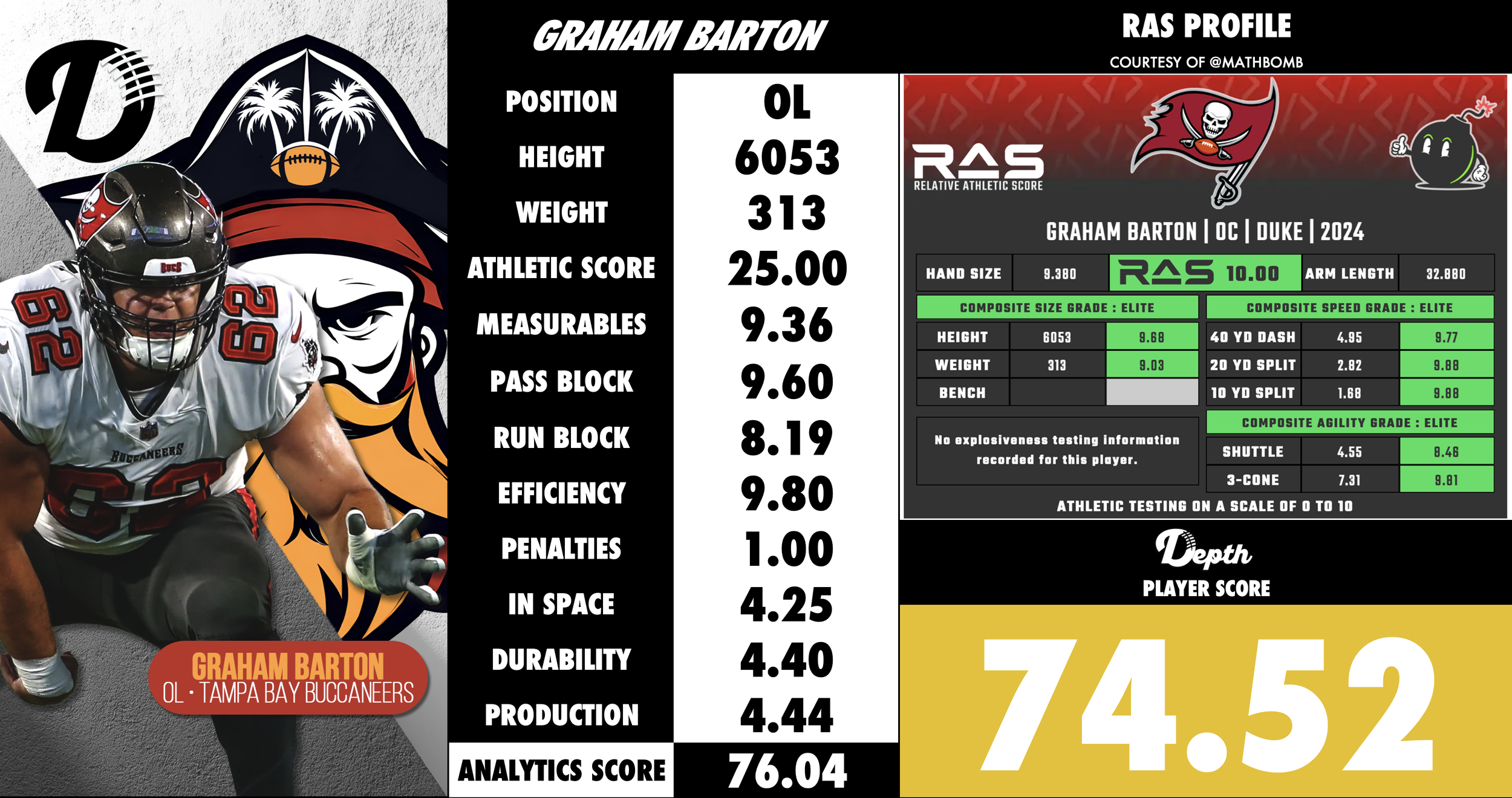
Graham Barton
Summary
Graham Barton was drafted in the 2024 NFL Draft, Round 1, (pick 26) out of Duke. Barton profiles as a highly-competent offensive lineman with a lot of encouraging traits: excellent run-blocking strength, good athleticism for his size, smart positional play, and versatility across the line. He brings a physical and gritty style that suits teams wanting a strong interior presence or a pulling, movement-capable lineman.
However, his fit as an elite blind-side tackle is questioned because of his reach and some athletic limitations versus elite edge speed. The better projection for him in the NFL is likely at guard or center — where his run-blocking explosion, strength and IQ can shine without being exposed by the most extreme athletic match-ups.
In short: Barton offers a high floor as a starter in the NFL, with considerable upside if his transition to the interior goes smoothly. His ceiling may be tempered slightly compared to the most athletic tackles, but his toughness, technique and versatility give him a strong profile.
Strengths
Strong run-blocking ability & finishing-blocks mentality: Barton is praised for his physicality, burst off the snap, his ability to generate movement in the run game and finish blocks through the whistle.
Very good technique, footwork, and mobility for his size: Despite his size, he shows quick feet, agility to move in space (especially as a pulling lineman or on the second level), and good hand placement. Cheesehead TV
Versatility & football IQ: He has experience at multiple line positions (center, left tackle) and shows the mental processing, positioning and leverage awareness to adapt. Behind the Steel Curtain
Competitive toughness & anchor strength: Reporters note his low center of gravity, strong anchor ability especially in run-blocking, and his willingness to engage physical battles. Cheesehead TV
Weaknesses
Length/arm-reach concerns for tackle role: One of the recurring critiques is that his arm length and overall reach are somewhat below ideal for an NFL left tackle, which affects his margin against elite edge rushers.
Best fit likely interior rather than blind-side tackle: Many evaluators believe that while he excelled at tackle in college, in the NFL his optimal position may be guard or center due to the athleticism demands and reach issues of tackle. firstroundmock.com
Some issues vs ultra-athletic rushers & in space: While strong in power and technique, there are times when he’s vulnerable to quick change-of-direction edge rushers, deeper reach plays, or when asked to mirror very agile opponents. cobalt-garlic-6kdt.squarespace.com
Relatively limited snaps at interior in college & positional transition risk: Since much of his college career was at tackle, shifting fully to center/guard brings transition risk (snap-exchange, interior leverage, different blocking angles) for the pro level. Behind the Steel Curtain
Fit & Outlook
Fit:
Ideal in offenses or line schemes that emphasise power, zone-run concepts, motion/pulling linemen, and where interior strength or second-level movement is prized.
He can excel in systems that allow him to play guard/center or slide inside rather than locking him as a left-tackle playing wide-9 speed rushers every down.
Less ideal if forced into a scheme requiring pure mirror-speed, reach-rush neutralisation on the blind side, or wide-zone stretch blocks frequently against ultra-quick edge defenders.
Outlook:
Short-Term (Rookie): Barton is likely to earn immediate starter snaps (or near-starter) given his draft status, versatility, and readiness. Initially, he may be used at center or guard rather than tackle to optimise fit.
Medium-Term (Years 2-4): If he adapts fully to interior play, adds consistency in pass-pro, and avoids major physical mismatches, he has the potential to become a top-tier interior lineman.


